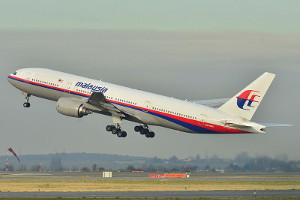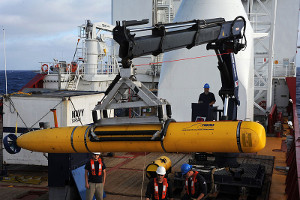Disappearance of Malaysia Airlines flight MH370
No trace of the missing aircraft
 The missing boeing © Laurent ERRERA, CC BY-SA 2.0 The missing boeing © Laurent ERRERA, CC BY-SA 2.0 |
Since the crash of flight MH370 on March 8th, 2014, search operations conducted by aircrafts, boats and underwater robot have multiplied relentlessly but to no avail. No debris has been found in sea to-date while the signals emitted by the aircraft black boxes have been fading away. The search area is huge: 60 000 km2 and 1 600 km from west Australian coasts.
Several countries have been involved in investigative operations including China, Australia, Japan and the United States which is endowed with sophisticated technical resources. The American drone Bluefin-21 began in late March the exploration of the seabed after the interruption of research by ships and aircrafts. Recourse to more efficient techniques that are able to map the seabed 4500 meters deep will soon be made.
A heavy bill
This loss could become one of the most expensive in aviation history. Allianz, which heads the insurers’ pool of the Malaysian company, estimated the insurable losses at 350 million USD, much higher than the initial forecasts. The cost of search operations, covered by the aviation insurance policy increased the bill.
Total loss of the aircraft
Malaysia Airlines fleet is insured by a consortium including Allianz which is the primary insurer. Two weeks after the disappearance of the Boeing, the airline received 110.2 million USD in aircraft hull compensation. According to the procedures in force, an aircraft which disappeared over two days is considered totally destroyed.
The most expensive search operations in aviation history
 The Bluefin-21 underwater robot The Bluefin-21 underwater robot |
Initially estimated at 100 million USD, search operations, poised to continue for several months, will greatly exceed expectations and reach a record level. Early search has already cost 44 million USD while as much as another 55 million USD are required to cover the costs for seabed exploration.
As a reminder, the two years of searching for the wreckage of the Air France (AF447) connecting Rio de Janeiro to Paris and lost at sea in June 2009 cost between 105 and 132 million USD which was a record of its own at that time.
Compensation for victims' beneficiaries
Relatives of victims would be compensated by the carrier regardless of any liability. The Montreal Convention sets a ceiling of 175 000 USD per passenger. This amount has to be paid automatically after damage is sustained and without awaiting the outcome of the investigation. Beyond this limit, it is up to the airline to prove that it has committed no fault.
Malaysia Airlines insurers have so far paid only 5 000 USD to victims' heirs in emergency financial assistance. Compensation amounts will surely be much higher than the limit set by the Montreal Convention as two other levels of compensation are likely to be added to this ceiling: compensation for moral and economic damage.
Compensation for the loss of a loved one. The damage is evaluated according to kinship ties with the victim and within the jurisdiction of the country.
Compensation for economic loss. The amount allocated to beneficiaries depends not only on the degree of kinship but also on the existing link of economic dependence between the beneficiaries and the victim (loss of spousal income, children or other dependents of the victim). Redress also depends on the age and on the financial and professional status of the victim.
Judicial and technical investigations
Recourse to justice is also possible for the victims' relatives. This procedure is often initiated by the heirs to obtain full redress and receive higher compensation. In the United States, the father of a passenger lodged a lawsuit against the manufacturer Boeing and Malaysia Airlines. The Paris prosecutor's office has also pursued a criminal investigation for manslaughter following the disappearance of four French passengers in the crash.
It is only at the end of the investigation, which is likely to last for many years, that the causes of the accident and responsibilities will be determined definitively. The accident would then be attributed to neglect of the carrier, failure of the manufacturer or a force majeure.
Five years after the crash of flight AF 447 Air France, an accident having many similarities with that of the MH370, the case is far from being resolved. Recent reports of second expert assessment, implicating the aircraft pilots, are strongly disputed by Air France.
Fleet of Malaysia Airlines
| Type of aircraft | Aircrafts in service | Number of passengers |
|---|---|---|
Airbus A330-300 | 14 | 283 |
Airbus A380-800 | 6 | 494 |
Boeing 737-400 | 11 | 144 |
Boeing 737-800 | 50 | 160-166 |
Boeing 777-200ER | 15 | 282 |
Total | 96 | - |
Main accidents of Malaysia Airlines
| Date | Locations | Type of aircraft | casualties | Cause |
|---|---|---|---|---|
March 8th2014 | Indian Ocean | Boeing 777-200ER | 239 | Unknown |
December 13th, 2013 | Kuala-Lumpur | Boeing 737-800 | 0 | Aerodynamic whirlwind |
August 1st 2005 | Perth, Australia | Boeing 777-2H6ER | 0 | Malfunctioning |
March 15th, 2000 | Kuala-Lumpur | Airbus A330-300 | 0 | Unloading accident |
September 15th, 1995 | Tawau, Malaysia | Fokker F50 | 34 | Driving error |
December 18th, 1983 | Subang, Indonesia | Airbus A300-B4 | 0 | Weather conditions |
December 4th, 1977 | Tanjung Kupang, Malaysia | Boeing 737-200 | 100 | Hijacking |
